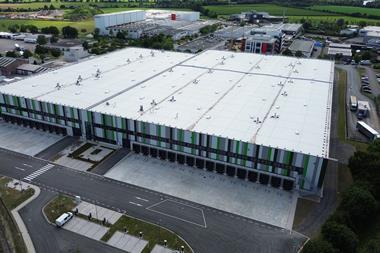Decarbonising logistics and real estate is key, but scaling HGV electrification is challenging, writes Stefano Fissolo
Decarbonising the energy used to power logistics operations and real estate is critical to meeting climate targets and reducing energy costs.

But with ambitious plans to electrify HGV fleets particularly high on the agenda, there remain several key obstacles to overcome in achieving a transition to clean energy and physically delivering this source of energy to businesses, at scale.
Path to electrification – who pays?
The upfront cost to install onsite clean energy sources like rooftop solar, and then electrifying HGV fleets is substantial.
Solar installations are becoming more prevalent in the European logistics real estate market due to becoming more affordable, allowing customers to make savings on their electricity bills from day 1 in most European countries. Moreover, it offsets scope 2 emissions and is secured by allowing tenants to fix prices for long term leases.
Tenant-occupied logistics real estate portfolios still show a 5% to 25% share of properties equipped with PV, according to a recent study of JLL, but landlords want to increase the solar penetration substantially and quickly.
Thanks to the tenants’ demand for clean power produced onsite, capital is available to sustain upfront investments at scale either through landlord direct investments or solar developer owners.
Once onsite solar is set up on a property, there are more opportunities to decarbonise logistics operations such as electrifying fleets, battery storage and heat pumps.
However, future electric fleets will need to access new sources of charging infrastructure, which carries additional investment not only in equipment but also in substantial civil and electrical works, such as grid connection upgrades.
The total cost of ownership of an electric fleet is similar or lower than a traditional petrol run fleet, provided the electricity tariff – which usually includes the amortisation of the charging infrastructure – is significantly lower than what is currently charged to passenger EVs in fast charging stations.
This is achievable by powering the chargers with onsite solar and associated batteries, but it is much more difficult if the electricity is purchased from the grid.
Logistics providers also need to consider how they will adapt charging practices to fit with operational requirements. When and where vehicles charge will have significant implications for business operations, which is particularly relevant for supply chains and the range requirements of electric trucks delivering goods.
Given the speed of charging when compared to re-fuelling non-electric vehicles, there is potentially more downtime and with that a higher cost. Typical operations are inbound in the morning and outbound in the afternoon, but that requires rethinking when charging time needs to be factored in.
Then there is the question of who has the responsibility for delivering the charging infrastructure that is going to be needed to supply the power needed. Is it the energy provider, landlord or the tenant?
Charging infrastructure and investment in electric vehicles is a classic chicken-and-egg dilemma, and both carry risk and cost.
To break this chicken-and-egg loop, new catalysers such as government subsidies and regulations are required, together with partnerships with providers to help deliver the new infrastructure and technology that is needed. Delivery of clean energy solutions will require collaboration and commitment.
The supplier can only commit to charging infrastructure if the client themselves commits to using it over a long period of time.
Collaboration between landlord and tenant needed to achieve a smooth transition
Options for transitioning to an electric HGV fleet need to be carefully thought through. Where is the best place to start? Is the best approach to pilot in one country before expanding to others? Is charging best managed onsite or at charging hubs across supply routes?
Ultimately, businesses must be willing to explore and commit to options, which can be challenging during times of economic uncertainty. Comprehending the different options, particularly when there are limits to standardisation, requires a full understanding of different strategies, options and costs.
Exploring new technologies and developing collaborations and partnerships is all part of that learning curve.
Finding space for charging hubs can be an additional obstacle to overcome, but landlords can help with land optimisation and the consideration of available space in logistics yards and adjacent to existing warehouse premises.
There is a collective incentive and benefit for the charging infrastructure operator, landlord and end user to work together to achieve this.
Delivering clean energy at scale is a complex task and requires the logistics industry to carefully navigate a fast-moving landscape, understanding both the challenges to implementation and the new solutions already at their disposal—only through bold collaboration and decisive action can the industry drive towards a sustainable future.
No doubt that the capital availability will follow at that point.
To read the latest IPE Real Assets magazine click here.


















